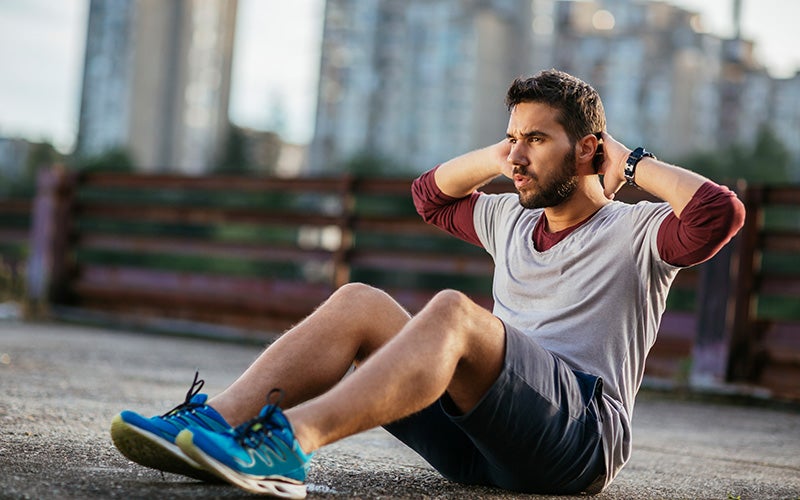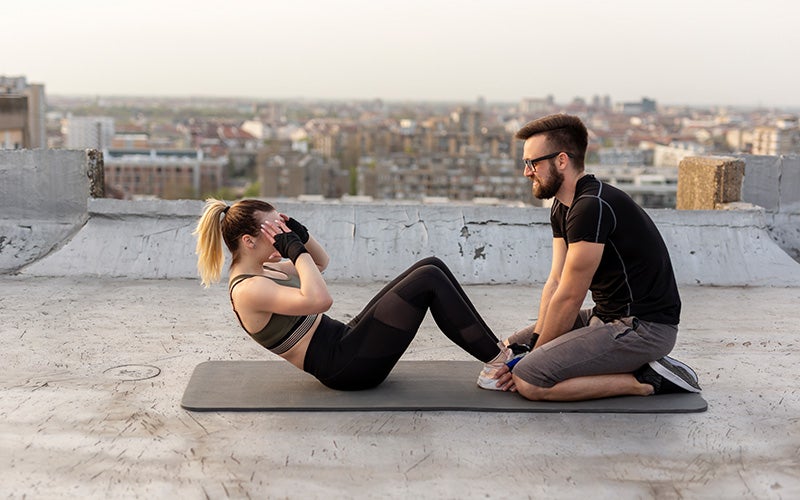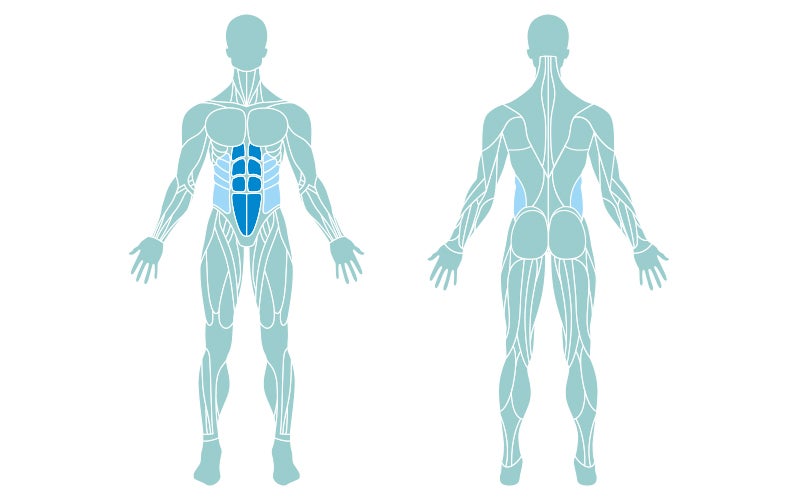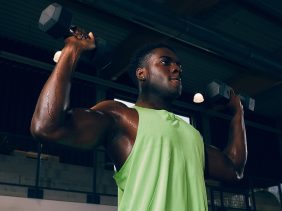Sit-ups: Techniques, benefits and variations on the classic core exercise
 ©Geber86
©Geber86
If you want to build abs, then sit-ups are an effective exercise that will help you strengthen them. Let us show you how to do them correctly, how many variations there are, and what happens if you do them every day.
What are sit-ups?
The sit-up is a popular exercise to train your abdominal muscles without any equipment. The term refers to the way it is performed: as you do one, you move from a lying position to an upright seat by moving your torso towards your thighs. This activates the rectus abdominis muscle in particular.
So if you intend to train your abs, you should definitely be familiar with these moves. One advantage they carry is that you don’t need any equipment. It’s an ideal pure bodyweight workout. For more intensity or variety you can of course always include dumbbells, a resistance band, exercise ball, or other equipment.
Are you getting the urge to work out? With our free foodspring workouts you can train effectively and efficiently at home. Tailored to your goals and your training level, you can decide from one of our many different workouts.
What is the difference between crunches and sit-ups?
If you’re looking for effective abs exercises, crunches will be found right up there, too. Their designs are similar, as both start in the supine position with bent legs, but there are some small but subtle distinctions:
On the other hand, crunches only involve lifting the upper back and shoulder blades from the floor and pressing the abdominal wall together by slightly rounding it, hence the term ‘crunch’.

With the sit-up, you lift your entire upper body from the floor and straighten your back completely. This variation is much more demanding and requires more abdominal and back tension. Therefore, beginners are often advised to start with crunches first.
What is the benefit?
The sit-up is an isolation exercise, i.e. you train a certain muscle group in isolation, in this case the rectus abdominis. They activate your core and are targeted to stimulate muscle development.
If you are working on six-pack abs, it makes sense to integrate the sit-up into your training. Besides the visual appeal, strong abs have other advantages: in conjunction with the back muscles, they stabilize and support the spine. You can improve your posture, prevent an overarched back and other back problems.
In addition, a well-trained core improves balance and muscle tone, which can benefit your performance in all kinds of sports – whether weight training, running, or yoga.
The important thing is: It’s the combination that counts. So you shouldn’t focus completely on sit ups, but also include other abdominal and back exercises in your training.
Are sit-ups good for the back?
Training the abdominals provides an important counterbalance to strong back muscles. Together, the abdominal and back muscles provide a stable core.

That’s why sit ups are a good abdominal exercise for people with a healthy back. If performed correctly, they can help reduce stress or excessive strain, e.g. from sitting for too long. If the abdominal muscles are too weak, this can lead to imbalances in the spinal column. At worst, joints, ligaments and discs may be damaged.
If you already suffer from discomfort in the spine, the best thing to do is to consult a trainer before abdominal training. To approach the sit-up more gradually and benefit from its positive effects, you can start with crunches or try a slightly easier sit-up alternative, like using an exercise ball or a resistance band for support.
What muscles do they train?
Sit-ups focus on the rectus abdominis muscles, but if performed correctly, the oblique and deep muscles of your core are also strengthened. The hip flexor is involved in straightening up, as well.

The primary target muscle groups of sit ups are:
- Rectus abdominis / abdominal muscle: The abdominal muscle is what’s responsible for visual six-pack abs and is an important postural muscle. It pulls the chest towards the legs and keeps the trunk bent.
- Musculus pyramidalis / pyramidalis muscle: The pyramidal muscle is a triangular skeletal muscle that is anterior to the rectus abdominis. It strengthens the connection between the abdominal and pelvic floor muscles..
The secondary target muscle groups of sit ups are:
- Musculus obliquus internus abdominis, Musculus obliquus externus abdominis / Internal & external oblique abdominal muscles: The lateral abdominal muscles are responsible for rotation in the upper body and contribute to a narrow waist and defined abs.
- Musculus psoas major / Hip flexor: In the hip joint, the muscle causes flexion and is also responsible for outward rotation (external rotation).
How many calories do they burn?
The number depends on many factors, such as age, gender and weight, as well as your pace and muscle tone, so it’s difficult to generalize.
To increase your calorie consumption during a workout and work on your six-pack at the same time, you can do Sit Ups. The HIIT training method is particularly well-suited for that – it’s ideal for burning as much energy as possible in a short time.
The fact is, the more muscle mass you have, the more calories you burn, even when at rest.
An important point: Your abdominal workouts are not really what’s responsible for a visible six-pack. Because although they strengthen your muscles, you cannot deliberately target weight loss straight to your belly fat. The saying “abs are made in the kitchen” is not entirely unreasonable – it means your diet is a major catalyst for core definition.

So, in addition to exercising, make sure you eat a protein-rich diet and support your body with essential nutrients. A good supplement for all those who are working on their fitness and figure is our Whey Protein – like a delicious milkshake, but loaded with high-quality protein for tired muscles.
How many should you do daily?
More isn’t necessarily always better. Like with many other things, finding the right workout routine is crucial for abdominal toning. For muscles to grow, they need not only regular training but also recovery. Regeneration is essential!
Training your abdominal muscles every day therefore makes little sense. It is better to do 4 x 20 sets three to four times a week than 100 daily. In addition, you also work your abs in many other exercises such as squats, push-ups, or lunges as well as endurance sports. So always take a little break between your sit-up sessions.
What happens if you do them every day?
If you do sit ups every day, you will feel that your abdominal wall becomes firmer and firmer over time. However, daily abdominal muscle training is not recommended if you want to lose weight or are looking to build up muscles.
The most important factors for this are nutrition, a well structured training plan, and sufficient rest. If you train without these recovery phases of 24 to 48 hours per muscle group, your progress may slow down and your performance may drop, which is exactly the opposite effect of what you hope for from your sit-up sessions.
Execution: How to do a correct sit-up
For a proper sit-up, follow the step-by-step instructions below:
– Lie with your back on the floor and your knees bent, keep your legs open about hip-width and place the soles of your feet or heels on the floor. Place your feet just far enough away from your buttocks that your fingertips meet your ankles.
– There are a variety of options for the arms. For beginners, position them stretched out beside the upper body and lift them off the ground. More experienced athletes can cross them in front of the chest or hold the fingertips to the temples.
– Now tense your abdomen and sit up with control by lifting your upper body from the floor bit by bit and bending your hips. Deliberately pull the shoulder blades down and back to keep the upper back straight. A slight flexion in the lower back is perfectly normal to reduce strain on the hip flexor.
– Exhaling slowly, guide the upper body toward your thighs and maintain the tension at the top.
– While inhaling, lower yourself vertebra by vertebra to the floor, keeping your shoulder blades in the air. Repeat.
Note: Keep your back straight the whole time, deliberately pulling your shoulder blades backwards and down. The chin should be tucked in slightly towards the chest. Think of the neck as an extension of the spine. If you have your hands behind your head or on your temples, you should be careful not to pull your head along. The power should come completely from your core.
Are you getting excited to work out? With our free foodspring workouts you can train effectively and efficiently at home. Tailored to your goals and your training level, you can choose from our many different workouts.
The most effective sit-up variations
There are many different variations of the sit-up. With the support of equipment like an exercise ball or a resistance band you can make the abdominal work a little easier and gentler. A more intensive sit-up can be done with dumbbells or kettlebell, for example. By varying the position of your arms or legs and twisting your upper body, you can add variety to your routine. Here are five options:
Butterfly Sit-up
Lie on your back and place the soles of your feet together. With your knees bent, let them fall outwards – like a butterfly. Stretch your arms over your head, straighten up from the strength of your abs and touch your feet with your hands. Alternatively you can clap your palms on the floor in front of you. Return to the starting position in a controlled manner and repeat the movement. The faster you do it, the greater the cardio component. The Butterfly Sit-up is, not without reason, a popular strength endurance exercise for HIIT workouts.
Sit-up with an exercise ball
Instead of lying on the floor, start by lying down on an exercise ball. Place your feet firmly on the floor. Your tailbone should be on the ball and your entire lower back should be supported up to the lower part of your shoulder blades. Your upper back should float gently. Bring your hands behind your head and slowly roll up with your upper body. Do not pull at your head, as the hands are to be used as only a light support. Pull the navel towards the ribs and keep the tension in your torso even when lowering.
Sit-up with a resistance band
This variation is ideal for beginners who want to approach sit-ups slowly. Loop a band around your feet and hold both ends with your hands. The force of the latex resistance band will make it easier to sit up. For a higher intensity you can stretch your legs straight on the floor instead of bending them.
Sit-up with dumbbells
For the more advanced, sit ups with extra weight are a good option. Hold one dumbbell in each hand (alternatively a heavier dumbbell or kettlebell in front of the chest) and tense your stomach firmly. When you reach the top, you can punch up into the air with the dumbbells or raise them above your head towards the ceiling. Both variations intensify the movement.
Sit-up with twist
Start by lying down on the mat with your legs hip-width. Choose an arm position: cross your arms in front of your chest, clasp your hands in front of your stomach in a pistol shape, or bring your fingertips to your temples. Lift the shoulder blades off the floor, tense the stomach firmly and straighten up. Rotate to one side in the upward movement. Bring the elbow to the opposite knee or the outstretched arms along the side of the opposite leg. Return to the floor and do it again on the other side. This version specifically works the lateral abdominal muscles.
Sit-up Alternatives
If you want to vary your abs training or if a sit-up are still a little demanding for you, the following exercises are effective alternatives to the classic sit-up:
- Plank
- Mountain Climbers
- Crunches
- High Knees
- Russian Twist
- Leg Raises
- V-Ups
- Flutter Kicks
Common mistakes
#1 You’re tucking your torso too much
If you don’t yet have sufficient abdominal tone, it’s possible that you will curl up with your upper back and neck before straightening your upper body. When you start to sit up, however, you should come into the seat as straight as possible, only with a slight bend in your lower back. If this doesn’t happen easily, start with crunches.
#2 You are arching your lower back
You should definitely avoid arching your lower back in order to protect it. Deliberately push your pelvis forward and pull your navel under your ribs. Keep this tension during both the up and down movements.
#3 You are pulling up on the back of your head
Put your hands on your head and keep them there without pulling yourself up with your hands. Pulling can lead to neck problems. Alternatively, hold your arms to the side.
#4 You are relying on momentum
You can do them at high speed, but you should be careful to keep a controlled movement. The power comes from the core of your body, not from your legs, arms, or upper back. The more slowly you move, the more muscle tension you work to build.
#5 You are holding your breath
Abs exercises can cause you to lose your breath. As soon as you catch yourself starting to either lose or hold your breath, find your calm again: exhale when you straighten up, inhale when you lower.
Sources for this article
We at foodspring use only high-quality sources, including peer-reviewed studies, to support the facts within our articles. Read our editorial policy to learn more about how we fact-check and keep our content accurate, reliable, and trustworthy.
































